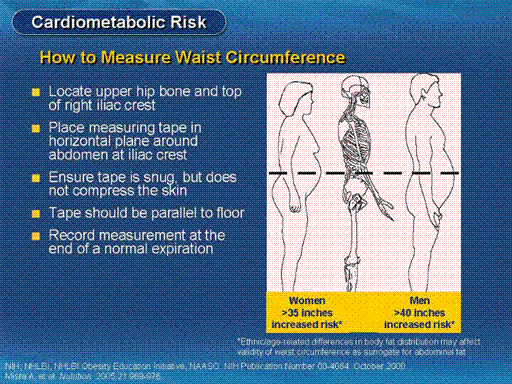| front |1 |2 |3 |4 |5 |6 |7 |8 |9 |10 |11 |12 |13 |14 |15 |16 |17 |18 |19 |20 |review |
 |
To measure waist
circumference, 1) locate the upper hip bone and the top of the right
iliac crest,
2) place the measuring tape in a horizontal plane around the abdomen at
the iliac crest, 3) ensure that the tape is snug but does not compress
the skin, 4) the tape should be parallel to floor, and 5) record the
measurement at the end of a normal expiration.
Men are at increased
relative risk if they have a waist circumference greater than 40 inches
(102
cm); women are at an increased relative risk if they have a waist
circumference greater than 35 inches (88 cm).
There are ethnic- and
age-related differences in body fat distribution that may affect the
predictive validity of waist circumference as a surrogate for abdominal
fat.
Heterogeneity of
composition of abdominal tissues, in particular adipose tissue and
skeletal
muscle, and their location-specific and changing relations with
metabolic factors and CV risk factors in different ethnic groups do not
allow a simple definition of abdominal obesity that could be applied
uniformly. In particular, Asians appear to have higher morbidity at
lower cutoff points for waist circumference than do white Caucasians.
National Institutes of
Health, National Heart, Lung, and Blood Institute, NHLBI Obesity
Education Initiative, North American
Association for the Study of Obesity. The practical guide to the
identification, evaluation, and treatment of overweight and obesity in
adults. NIH Publication Number 00-4084. October 2000.
Misra A, Wasir JS, Vikram
NK. Waist circumference criteria for the diagnosis of abdominal obesity
are not applicable uniformly
to all populations and ethnic groups.
Nutrition.
2005;21:969-976.
|